Last summer, while walking sections of the Menalon Trail in the Central Peloponnese, we visited a “Secret School” where during the centuries-long Ottoman era, children were covertly taught national traditions, culture, and the Greek language. The school was situated in cliffs high above the Lousios Gorge below Dimitsana, and from even a short distance away, was impossible to see.
And astonishingly, there is a similar school only an hour’s drive and then a short walk away from Paleochora, high in the hills above Palea Roumata, one of my favourite villages. It’s at the tiny church of Agios Giorgos, close to Chamalevri.
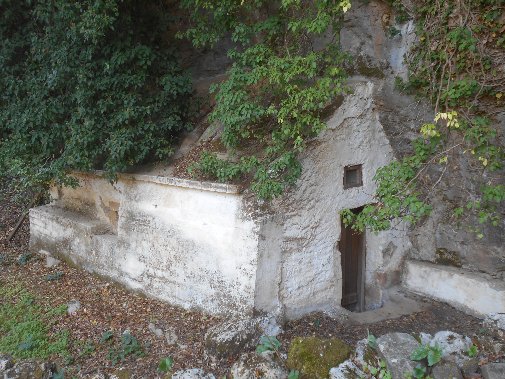
We thought to walk up from Palea Roumata, but a long and steep 5 km on roads was off-putting, so we drove there. From Kakopetros over to Kechres, then a narrow road (signed) to Chamalevri, which ended by some remote houses with barking dogs.
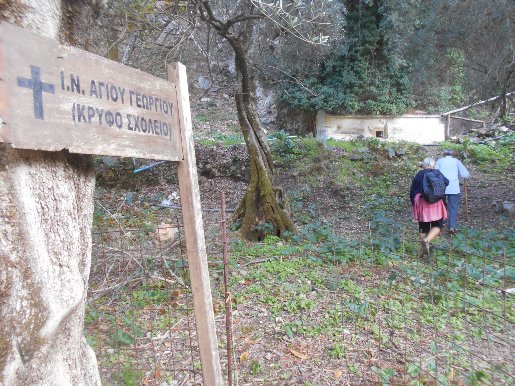
A resident gave us directions, which seemed complicated ; then he called into his house, and an elderly man emerged. “He will take you there,” we were told, and after collecting his wooden *’katsouna’* staff, he did. Along a grassy track, over a stream, through olive, oak, plane and chestnut trees into a leafy valley, to reach a tiny, almost concealed chapel built into a rock wall.
The Turks occupied Crete from 1669 – 1898, and folklore relates that students came from as far away as Platanias on the north coast, and from Sklavopoula away to the west to attend the school. Tragically and terribly, treachery and betrayal led to its existence and location, and the Turks surrounded the school, slaughtering seventy children and the monk who taught them.
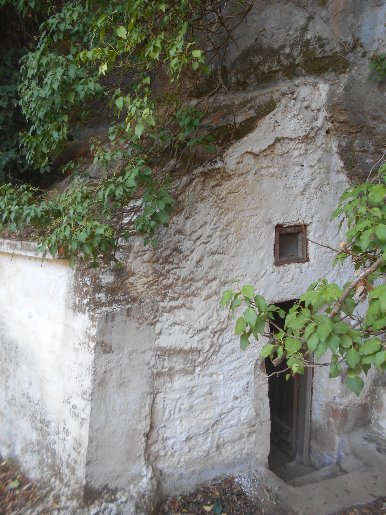
The church was unlocked, dark and almost cave-like inside. Outside, a wooden table and seats allow what must be rare visitors to rest and contemplate events which took place here.
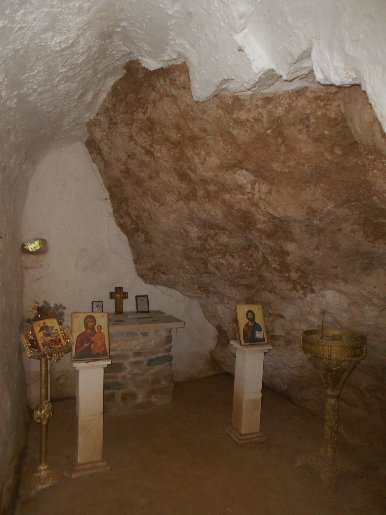
We walked back up to Chamalevri with our guide, thanked him profusely, then drove down through Lidiana to Palea Roumata. And of course, went for a walk.
Two gorges, the Vavouledo and Trachinos, converge a short distance above the village. The former is a very pleasant excursion with no difficulties, the latter a route requiring caution, experience, and the use of fixed ropes.
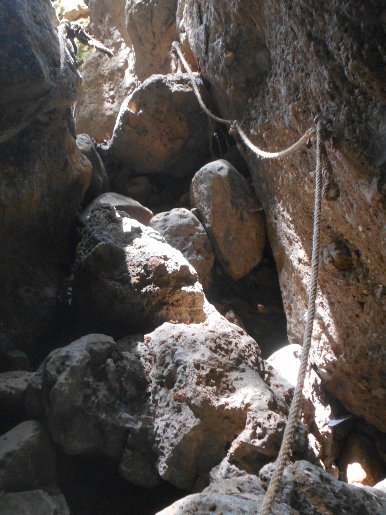
Both gorges have been restored recently, after damage during the severe winter storms of 2018/19, now with information boards at the starts, and waymarking throughout. The two can be walked separately, or combined to give a fine “expedition” of around three hours, before a meal later at the excellent Mpompolis taverna, which is what we did.
The approach to both gorges is initially the same, leaving the platea below the church in Palea Roumata along the road on which you entered.
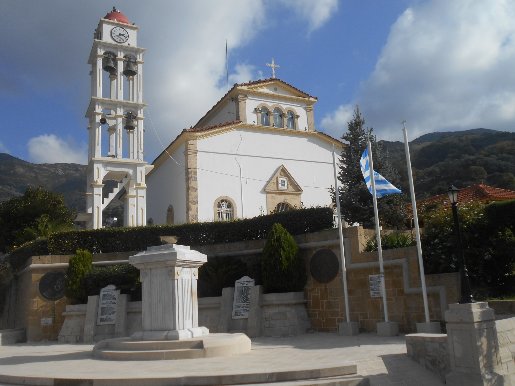
To reach the head of Trachinos Gorge, pass the Ancient Olive Tree to reach the soccer stadium, not quite Old Trafford or the San Siro, and literally grass roots level. Opposite (signed Trachinos 1.5km) take the road to Lidiana, walk on through the village then turn left to reach the Information Board above the riverbed.
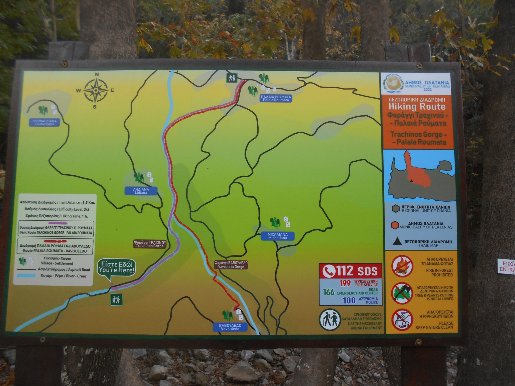
The way to (the foot of) Vavouledo Gorge is shorter and easier. From the church, walk just 100m back down the road to an Information Board, and then between houses (signed), later swinging right on a grassy track. This leads pleasantly to the river bed, once a small stream, devastated by winter torrents. Follow arrows down into, and then alongside to reach the gorge.
Now comes (rated by me at least) one of the most attractive short walks on Crete, a ‘hidden gem.’ Depending on conditions, you may need to cross and re-cross the stream several times, taking care over often slippery ‘stepping stones.’ After half a km, you’ll reach the junction with Trachinos Gorge, joining from the right.
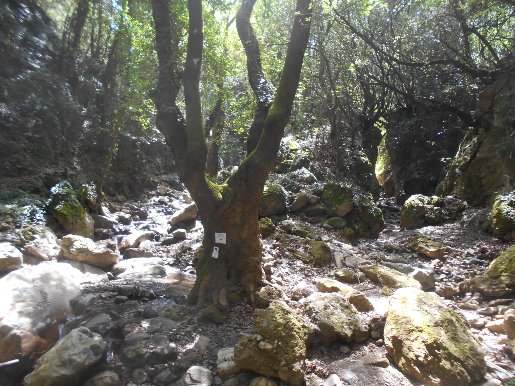
Explore if you will, but “remember that courage is nought without prudence …” and this gorge is narrower and rockier underfoot. After some ten minutes the first ‘Caution’ is reached ; if you negotiate this, pass beneath a huge wedged boulder to the first ‘fixed rope’ climb. Better to retreat here and return to the Vavouledo …

Onwards, with sunlight filtering through a canopy of tall trees, passing picnic areas to reach a wooden footbridge.
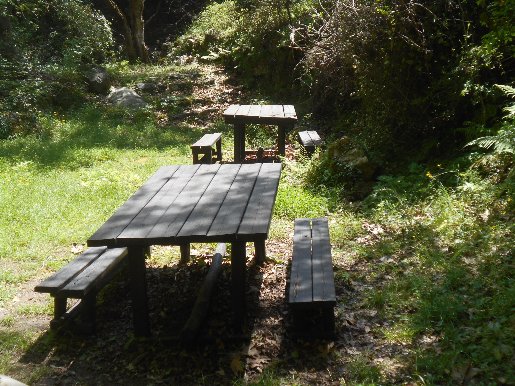

Here the path leaves the gorge, rising into Vavouledo where there is spring water and, occasionally in summer, a small taverna. If you’ve not been, turn right to visit the 11th century church of Ag. Vasileios. Follow the road out of the village, which will soon turn north and leads easily back into Palea Roumata.
A meal at Mpompolis is an experience not to be missed. There’s no ‘Menu’, but Chrissoula will tell you what’s on offer, with almost all local produce, the meat dishes especially.
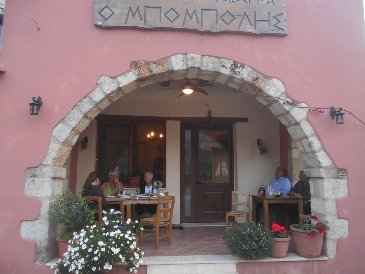
Then back to the platea, checking the time on the church clock (always wrong …) and inevitably being startled when it chimes, almost deafeningly and seemingly randomly.
Palea Roumata never fails to delight, and more than justifies the short journey from Paleochora.
And there are more secrets still to discover. Google maps indicate three waterfalls in streams above the village, which after heavy rain, will give more opportunities to Explore ! in this area.


1 comments
Kalimera, on November 2, 2022 I walked with a friend through the Vavouledo gorge and the Trahinos gorge, near Palea Roumata. We walked both gorges from Palea Roumata, to the hamlet of Vavouledo and the church of Agios Vasileios and back to Palea Roumata. The kafenio in Vavouledo has unfortunately been closed for several years.
Despite the isolated location of Palea Roumata, the place makes a very friendly impression. There is a nice calmness here, hustle and bustle is a foreign word here.
Palea Roumata is 38 km away from Paleochóra. In Palea Roumata there is a tavern, 2 kafenea and a mini market. A folklore museum (Laografikó Mouseío), a women’s agricultural cooperative and an olive oil factory. Worth seeing is also the monumental olive tree Palea Roumata.
The olive tree was declared a monument by the Association of Olive Communities of Crete because of its size, the external reliefs and the large internal fullness (hole) that its trunk bears, as well as its connection with historical events in the village.
The age of the tree is estimated at about 3,000 years. According to the villagers, the cavity of the large tree, which can accommodate four to five people, was used as a weapons cache during the Turkish occupation, hidden in a vessel in a pit inside the tree. According to the villagers, the same cave was also used as a meeting place during the occupation of Crete by the Germans in 1941, where the village committee of villagers met to decide on the village’s resistance to the conquerors. From the same cave the villagers took weapons during the battle in Anavos against the German troops in the same year.
Ta Leme, kv